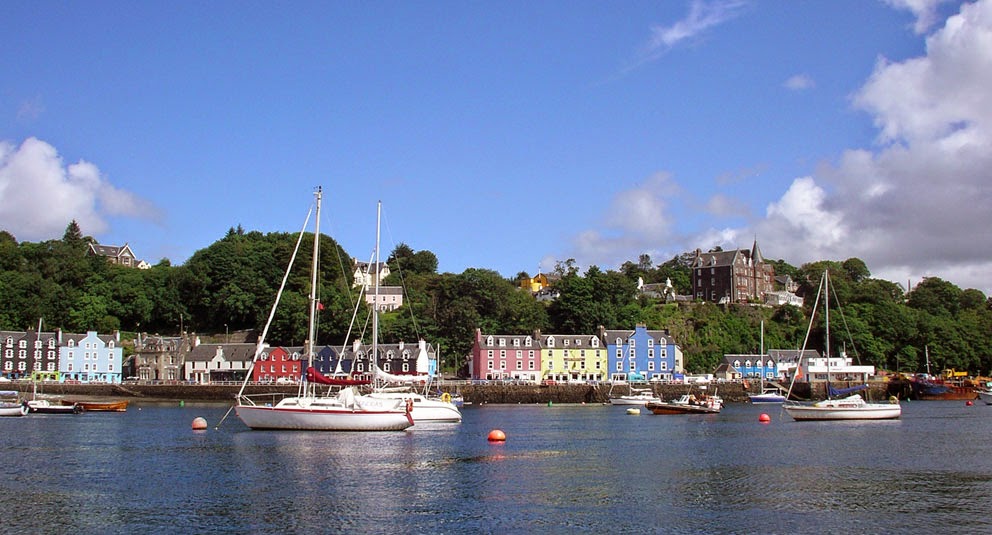Over the years thieves have robbed the Hebrides of hundreds of sacred treasures. One hopes that some of the missing items are held locally for safekeeping, but who knows. Below is a summary of several treasures I would love to see, whose whereabouts are unknown.
St Kenneth's Bell - Inchkenneth
Last seen on the altar of Inchkenneth Chapel. Boswell and Johnson saw it in 1773:
Our attention, however, was sufficiently engaged by a venerable chapel, which stands yet entire, except that the roof is gone. It is about sixty feet in length, and thirty in breadth. On one side of the altar is a bas relief of the blessed Virgin, and by it lies a little bell; which, though cracked, and without a clapper, has remained there for ages, guarded only by the venerableness of the place. The ground round the chapel is covered with gravestones of Chiefs and ladies; and still continues to be a place of sepulture.
 |
| Inchkenneth Chapel |
The Chin of McMarcus
I posted on this strange stone on Seil island three years ago (
see this link). It was described by T. Ratcliffe Barnett in his 1937 book
Highland Harvest:
A curiously shaped fragment of basalt, resembling a human chin, rests upon the slab. It is known as "Smig mhic Mharcuis" (the chin of MacMarquis). It is popularly believed that this stone, by some supernatural power, revolves upon its axis and points with the chin to a new-made grave, remaining in the same position until a fresh interment takes place. It is also said that should the "chin" be removed from its place on the stone it will always return. Certainly on more than one occasion the stone has been stolen, but sooner or later was found resting in its old position.
I have visited the cemetery where the chin once rested, and was fooled by a fake 'stand-in' stone. Based on an old drawing I came across later, the real chin looks like one of the water-worn Bodach and Caillach stones found on Gigha and in Glen Lyon. I have a feeling the true chin is safely stashed in a nearby home.
 |
| Drawing of the chin from Patrick Gillies' Netherlorn and its Neighbourhood. |
 |
| The 'fake' chin-stone |
St Kessog's Bell
St Kessog's bell was once rung from the top of
Tom na Clag, the Hill of the Bell, on the island of Inchtavannach in Loch Lomond. It was last seen in the early 1800s hanging from a post in Loch Lomond.
 |
| Looking north from the Hill of the Bell |
The Bell of Kilvickeon
Another missing bell is the
Bell of Kilvickeon, last seen in the chapel of Kilvickeon on the island of Ulva. Bells seem to be a common item purloined over the years. One wonders how long before St Finnan's Bell, still to be found on the Green Isle of St Finnan, disappears.
 |
| Kilvickeon |
There is hope that some of these missing treasures will be found someday. One such recovered item was the
Clanranald Stone, which went missing from Howmore Chapel (S. Uist) in 1990. I do not have a photo of the Howmore stone, but I have visited two other similar stones at Airisaig and Kildonnan Chapel on Eigg. In 1995 the Howmore stone was found in, of all places, a London flat. It was returned to South Uist in 1999, and can be seen in the
Museum at Kildonan.
 |
| Eigg's Clanranald Stone |
One hopes more missing treasures will be found someday. What would be astounding is if the most famous stone of them all, the true Stone of Scone, was found. Nigel Tranter speculated often that the stone, entrusted to the Lord of the Isles by Robert the Bruce, was hidden somewhere in the Hebrides. So next time you're hiking in the islands and come across a cave, take the time to explore it. Who knows what you may find.























































